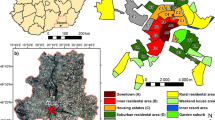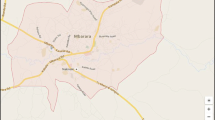Abstract
In Istanbul, one of the most densely populated cities of Turkey, the population has grown rapidly over the last 30 years. In addition to being one of the rapidly flourishing cities in Europe, the city is positioned on the seismically active North Anatolian Fault (NAF). The form and rate of Istanbul’s fast urban growth has serious implications for seismic hazards. There have been some studies to map lateral urban growth for the city but they do not give satisfactory information about vertical urban growth and seismic hazards. We use DMSP night lights and Landsat data to map changes in land cover-land use in and around the city since 1984, and determine relations of these changes with the NAF. Changes in land use and intensity of development are identified by changes in night light brightness while changes in land cover are identified by changes in land surface reflectance. Aggregate changes in reflectance are represented as changes in subpixel mixtures of the most functionally and spectrally distinct spectral endmembers of land cover. Using standardized global endmembers, SVD composite images were produced for 1984, 2000 and 2011 and fraction change (δSVD) maps were produced for the decadal intervals. The results show that most of the urban expansion has occurred near the NAF. This has serious implications for seismic hazards in the future if the progression of large earthquakes continues to move westward toward the city.













Similar content being viewed by others
References
Adams, J. B., Smith, M. O., & Gillespie, A. R. (1993). Imaging spectroscopy: Interpretation based on spectral mixture analysis. Remote geochemical analysis elemental and mineralogical composition (Vol. 7, pp. 145–166). New York: Cambridge University Press.
Al Rawashdeh, S., & Saleh, B. (2006). Satellite monitoring of urban spatial growth in the Amman area, Jordan. Journal of Urban Planning and Development, 132, 211–216. https://doi.org/10.1061/(ASCE)0733-9488(2006)132:4(211).
Ambraseys, N. N., & Jackson, J. A. (2000). Seismicity of the Sea of Marmara (Turkey) since 1500. Geophysical Journal International. https://doi.org/10.1046/j.1365-246X.2000.00137.x.
Armijo, R., Pondard, N., Meyer, B., Ucarkus, G., Mercier de Lepina, B., Malavieille, J., et al. (2005). Submarine fault scarps in the sea of Marmara pull-apart (North Anatolian Fault): Implications for seismic hazard in Istanbul. Geochemistry, Geophysics, Geosystems. https://doi.org/10.1029/2004GC000896.
Barka, A. (1996). Slip distribution along the North Anatolian Fault associated with the large earthquakes of the period 1939 to 1967. Bulletin of the Seismological Society of America, 86, 1238–1254.
Cormier, M. H., Seeber, L., Polonia, A., Cagatay, M. N., Emre, O., McHugh, C. M. G., et al. (2006). North Anatolian Fault in the Gulf of Izmit (Turkey): Rapid vertical motion in response to minor bends of a nonvertical continental transform. Journal of Geophysical Research: Solid Earth. https://doi.org/10.1029/2005JB003633.
Dalgic, S., Turgut, M., Kusku, I., Coskun, C., & Cosgun, T. (2009). The effect of soil and rock conditions on construction foundation on the European side of Istanbul. Applied Earth Sciences, Kocaeli University, 2, 47–70.
Dincer, I., Enlil, Z., Evren, Y., & Som, S. K. (2011). Istanbul’s historical and natural heritage values: Potential, risks and protection Issues (pp. 74–75). Istanbul: Istanbul Bilgi University Publications.
Emre, O., Duman, T.Y., Ozalp, S., Elmaci, H., Olgun, S., & Saroglu, F. (2013). Active fault map of Turkey with an explanatory text 1:1250000 scale. General Directorate of Mineral Research and Exploration, Special Publication Series, 30, Ankara, Turkey.
Erdik, M. (2003). Earthquake vulnerability of buildings and a mitigation strategy: Case of Istanbul. Washington, DC: World Bank.
Ergin, M., Ozalaybey, S., Aktar, M., & Yalcin, M. N. (2004). Site amplification at avcilar, Istanbul. Tectonophysics. https://doi.org/10.1016/j.tecto.2004.07.021.
Ergintav, S., Reilinger, R. E., Cakmak, R., Floyd, M., Cakir, Z., Dogan, U., et al. (2014). Istanbul’s earthquake hot spots: Geodetic constraints on strain accumulation along faults in the Marmara seismic gap. Geophysical Research Letters. https://doi.org/10.1002/2014GL060985.
Fichtner, A., Saygin, E., Taymaz, T., Cupillard, P., Capdeville, Y., & Trampert, J. (2013). The deep structure of the North Anatolian Fault Zone. Earth and Planetary Science Letters. https://doi.org/10.1016/j.epsl.2013.04.027.
Geymen, A., & Baz, I. (2008). Monitoring urban growth and detecting land-cover changes on the Istanbul metropolitan area. Environmental Monitoring and Assessment. https://doi.org/10.1007/s10661-007-9699-x.
Gillespie, A.R., Smith, M.O., Adams, J.B., Willis, S.C., Fischer, A.F., & Sabol, D.E. (1990). Interpretation of residual images: spectral mixture analysis of AVIRIS images. In Anual JPL airborne visible/infrared imaging spectrometer (AVIRIS) Workshop, pp. 243–290.
Google Earth 7.1.7.2606. (2002&2011). Asian side of Istanbul. 40°57′44.90″N, 29°14′11.91″E, DigitalGlobe 2015. https://www.google.com/earth/. September 23, 2015.
Google Earth 7.1.7.2606. (2002&2011). European side of Istanbul. 41°01′43.75″N, 28°44′36.45″E, DigitalGlobe 2015. https://www.google.com/earth/. September 24, 2015.
Google Earth 7.1.7.2606. (2001&2011). Istanbul. 41°03′57.62″N, 29°01′25.95″E, DigitalGlobe 2015-Terrametrics 2015. https://www.google.com/earth/. December 14, 2015.
Henebry, G., Zhang, X., Beurs, K., Kimball, J., & Small, C. (2015). Change in our MIDST: Toward detection and analysis of urban land dynamics in North and South America. In JURSE-201, Lousanne, Switzerland.
Jurgens, C., Siegmund, A., Maktav, D., Sunar, F., Esbah, H., Levent, T.B., Uysal, C., Kalkan, K., Mercan, O.Y., Akar, I., Thunig, H., & Wolf, N. (2011). Potential open space detection and decision support for urban planning by means of optical VHR satellite imagery. In 31. EARSeL symposium, pp. 628–637, Prague, Czech Republic.
Kaya, S., & Curran, P. J. (2006). Monitoring urban growth on the European side of the Istanbul metropolitan area: A case study. International Journal of Applied Earth Observation and Geoinformation, 8(1), 18–25. https://doi.org/10.1016/j.jag.2005.05.002.
KOERI (Kandilli Observatory and Earthquake Research Institute). (2015). National Earthquake Monitoring Centre, Bogazici University, http://www.koeri.boun.edu.tr/sismo/indexeng.htm. Accessed 22 May 2015.
Kurt, H., Sorlien, C. C., Seeber, L., Steckler, M. S., Shillington, D. J., Cifci, G., et al. (2013). Steady late quaternary slip rate on the Cinarcik section of the North Anatolian fault near Istanbul, Turkey. Geophysical Research Letters. https://doi.org/10.1002/grl.50882.
Le Pichon, X., Chamot Rooke, N., Rangin, C., & Sengor, A. M. C. (2003). The North Anatolian fault in the Sea of Marmara. Journal of Geophysical Research, 108, B4. https://doi.org/10.1029/2002JB001862.
Maktav, D., & Erbek, F. S. (2005). Analysis of urban growth using multi-temporal satellite data in Istanbul, Turkey. International Journal of Remote Sensing. https://doi.org/10.1080/01431160512331316784.
Maktav, D., Erbek, F. S., & Jurgens, C. (2005). Remote sensing of urban areas. International Journal of Remote Sensing. https://doi.org/10.1080/01431160512331316469.
Maktav, D., & Sunar, F. (2010). Remote sensing of urban land use change in developing countries: an example from Buyukcekmece, Istanbul, Turkey. Remote Sensing of Urban and Suburban Areas. https://doi.org/10.1007/978-1-4020-4385-7_15.
Maktav, D., Sunar, F., Taberner, M., & Akgun, H. (2000). Monitoring urban expansion in the Buyukcekmece District of Istanbul using satellite data. Amsterdam, Holland: ISPRS.
McClusky, S., Balassanian, S., Barka, A., Demir, C., Ergintav, S., Georgiev, I., et al. (2000). Global Positioning System constraints on plate kinematics and dynamics in the Eastern Mediterranean and Caucasus. Journal of Geophysical Research. https://doi.org/10.1029/1999JB900351.
McHugh, C. M. G., Braudy, N., Cagatay, M. N., Sorlien, C., Cormier, M. H., Seeber, L., et al. (2014). Seafloor fault ruptures along the North Anatolia Fault in the Marmara Sea, Turkey: Link with the adjacent basin turbidite record. Marine Geology, 353, 65–83. https://doi.org/10.1016/j.margeo.2014.03.005.
Ozmen, B. (2000). Gulf of Izmit earthquake of 17 August 1999, damage condition, TDV/DR 010-53, Turkey Eartquake Foundation.
Parsons, T., Toda, S., Stein, R. S., Barka, A., & Dieterich, J. H. (2000). Heightened odds of large earthquakes near Istanbul: An interaction-based probability calculation. Science, 288(5466), 661–665. https://doi.org/10.1126/science.288.5466.661.
Sengor, A. M. C., Tuysuz, O., Imren, C., Sakinc, M., Eyidogan, H., Gorur, G., et al. (2005). The North Anatolian Fault: A new look. Annual Review of Earth and Planetary Sciences, 33(37), 112.
Shanmugam, P., Ahn, Y. H., & Sanjeevi, S. (2006). A comparison of the classification of wetland characteristics by linear spectral mixture modelling and traditional hard classifiers on multispectral remotely sensed imagery in Southern India. Ecological Modelling, 194(4), 379–394. https://doi.org/10.1016/j.ecolmodel.2005.10.033.
Small, C. (2004). The Landsat ETM + spectral mixing space. Remote Sensing of Environment, 93(1–2), 1–17. https://doi.org/10.1016/j.rse.2004.06.007.
Small, C. (2014). Mapping urban growth and development as continuous fields in space and time, Revista do Departamento de Geografia; Volume Especial CartoGeo, Revista do Departamento de Geografia da Faculdade de Filosofia, Letras e Ciências Humanas da Universidade de São Paulo - Brasil. https://doi.org/10.7154/rdg.2014.0114.0007.
Small, C., & Elvidge, C.D., & Baugh, K. (2013). Mapping urban structure and spatial connectivity with VIIRS and OLS night lights. In IEEE proceedings of JURSE-2013, Sau Paulo, Brasil.
Small, C., & Milesi, C. (2013). Multi-scale standardized spectral mixture models. Remote Sensing of Environment, 136, 442–454. https://doi.org/10.1016/j.rse.2013.05.024.
Small, C., Perez-Machado, R.P., Barrozo, L., & Luchiari, A. (2015). Mapping decades of urban growth and development using muti-temporal spectral mixture models, In: Proceedings of XVII Symposio Brasiliero de Sensoriamento Remoto, João Pessoa, PB, Brasil.
Straub, C., Kahle, H. G., & Schindler, C. (1997). GPS and geologic estimates of the tectonic activity in the Marmara Sea region, NW Anatolia. Journal of Geophysical Research. https://doi.org/10.1029/97JB02563.
Sunar, F. (1998). An analysis of changes in a multi-date data set: A case study in the Ikitelli area, Istanbul, Turkey. International Journal of Remote Sensing. https://doi.org/10.1080/014311698216215.
Sur, H. (2012). Residential sector in Turkey. 5 t h Global Housing Finance Conference. Washington DC: World Bank.
Toksoz, M. N., Shakal, A. F., & Michael, A. J. (1979). Space-time migration of earthquakes along the North Anatolian Fault Zone and seismic gaps. Pure and Applied Geophysics PAGEOPH, 117, 6. https://doi.org/10.1007/BF00876218.
TurkStat (Turkish Istatistical Institute). (2014). http://www.turkstat.gov.tr/UstMenu.do?metod=temelist. Accessed 25 June 2014.
TurkStat (Turkish Istatistical Institute). (2015). http://www.turkstat.gov.tr/PreTablo.do?alt_id=1055. Accessed 21 May 2015.
USGS Global Visualization Viewer. (2012). http://glovis.usgs.gov/. Accessed 2-12 September 2012.
Acknowledgements
The authors express their gratitude to the Scientific Research Projects Department of the ITU, Scientific and Technological Research Council of Turkey (TUBITAK) for valuable support, and the Lamont-Doherty Earth Observatory (LDEO) of Columbia University for hosting the visit of Cihan Uysal.
Author information
Authors and Affiliations
Corresponding author
About this article
Cite this article
Uysal, C., Maktav, D. & Small, C. Mapping Urban Growth and Its Relation to Seismic Hazards in Istanbul. J Indian Soc Remote Sens 46, 1307–1322 (2018). https://doi.org/10.1007/s12524-018-0799-6
Received:
Accepted:
Published:
Issue Date:
DOI: https://doi.org/10.1007/s12524-018-0799-6




